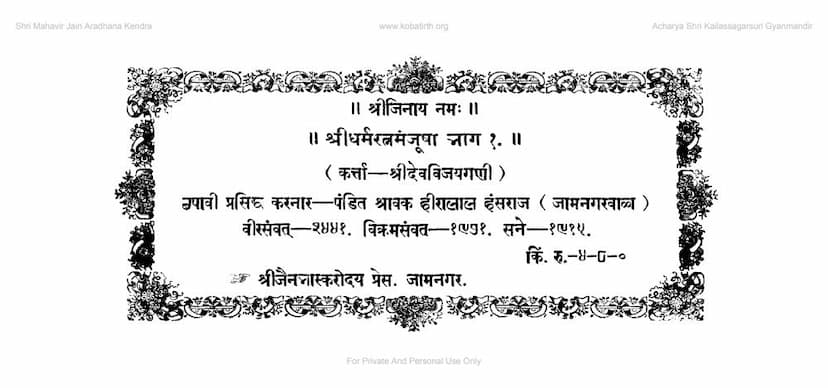Dharmratna Manjusha Part 01
Added to library: September 1, 2025

Summary
Here's a comprehensive summary of the provided Jain text, "Dharmaratna Manjusha Part 01," authored by Devvijay Gani:
Overview:
"Dharmaratna Manjusha Part 01" (Ocean of the Jewel of Dharma, Volume 1) is a significant Jain text authored by Devvijay Gani and published by Shravak Hiralal Hansraj. This work, part of a larger series, focuses on the principles and practices of Jain Dharma, with this first volume primarily elaborating on the concept and importance of Dana (Charity/Giving). The text is rich in stories, examples, and philosophical explanations aimed at guiding individuals towards righteous conduct and spiritual progress.
Key Themes and Content:
The book systematically explores the multifaceted nature of Dana and its profound impact on an individual's spiritual journey. It delves into:
-
The Nature of True Charity (Dana): The text emphasizes that true charity is not merely the act of giving material possessions but is rooted in compassion, righteousness, and a desire for spiritual upliftment. It distinguishes between various types of giving, highlighting the superiority of charitable acts performed with sincere intention and for the right cause.
-
The Results of Charity: Through numerous narratives, the book illustrates the auspicious outcomes and spiritual merits derived from practicing Dana. These results are shown to manifest not only in this life but also in future births, leading to favorable circumstances, prosperity, happiness, and ultimately, spiritual liberation. The text stresses that acts of charity contribute to accumulating positive karma (punya).
-
Illustrative Stories (Kathana): A significant portion of the book is dedicated to recounting various Jataka-style stories of past lives (purva-bhava) of prominent figures, including Tirthankaras and other significant souls. These stories serve as powerful examples to demonstrate:
- The Purity of Intention: How even seemingly small acts of kindness or charity performed with pure intention can yield immense benefits.
- The Consequences of Actions: The direct correlation between virtuous deeds (like Dana) and positive rebirths, and the opposite for unvirtuous actions.
- The Cycle of Karma: The continuous interplay of actions and their results across multiple lifetimes, emphasizing that every act of giving contributes to the karmic accumulation.
-
Examples of Specific Acts of Charity: The text details various instances of charity, such as:
- Giving Food (Anna Dana): The importance of providing food to the needy, ascetics, and fellow beings.
- Giving Medicine and Care (Aushadha Dana & Vaiyavritya): The merit in caring for the sick and providing them with necessary remedies.
- Donating Materials: Giving clothes, shelter, and other essential items.
- The Significance of Giving to Monks and Nuns: Special emphasis is placed on the profound merit gained by supporting mendicants and ascetics who have renounced worldly possessions for spiritual pursuits.
-
The Lifetimes and Rebirths of Key Figures: The text traces the karmic journeys of various individuals across numerous lifetimes, showcasing how their past actions, particularly acts of Dana, shaped their destiny. Notable figures whose past lives and rebirths are discussed include:
- Lord Rishabhanatha (Adinatha): His various births and how acts of charity influenced his path to becoming the first Tirthankara.
- Lord Mahavira: His previous births and the influence of his charitable deeds.
- Lord Shantinatha: His life story is extensively detailed, illustrating the power of charity and its impact on his journey to becoming a Tirthankara.
- Lord Neminatha: Mentioned in the context of his past lives and the importance of virtuous conduct.
- Vikramaditya: The king's exemplary practice of charity, his adherence to righteousness, and the divine interventions in his life are highlighted.
- Shalibhadra and Dhanayaset: Stories illustrating the consequences of different approaches to wealth and charity.
- King Udayana: His spiritual journey and the influence of his interactions with ascetics and virtuous individuals.
- Other significant characters: The text weaves in stories of various princes, merchants, and ascetics to illustrate specific principles.
-
Philosophical Underpinnings: Beyond the narratives, the text touches upon the philosophical underpinnings of Jainism, emphasizing concepts like:
- Ahimsa (Non-violence): As a foundational principle that guides all acts of compassion and charity.
- Right Faith (Samyaktva): The importance of correct belief as the basis for all virtuous actions.
- The Soul's Journey: The cyclical nature of birth, death, and rebirth, and how virtuous actions are crucial for spiritual progress.
- Renunciation (Tyaga): The significance of detachment from material possessions as a precursor to spiritual attainment.
Structure and Style:
The book employs a narrative style, using stories and illustrative examples to convey its teachings. It often begins by establishing the lineage and virtues of individuals before detailing their encounters and the impact of their actions. The language is descriptive and aimed at inspiring devotion and adherence to Jain principles.
Purpose:
The primary purpose of "Dharmaratna Manjusha Part 01" is to educate and inspire followers of Jainism, particularly laypersons (shravakas and shravikas), on the paramount importance of Dana. By showcasing the spiritual rewards of generosity, the book aims to encourage a life of righteousness, compassion, and selfless service, ultimately leading to the accumulation of merit and spiritual liberation.
In essence, "Dharmaratna Manjusha Part 01" is a devotional and instructive text that uses compelling stories and philosophical insights to illuminate the path of charity as a cornerstone of Jain spiritual practice and a crucial element for achieving ultimate well-being and liberation.